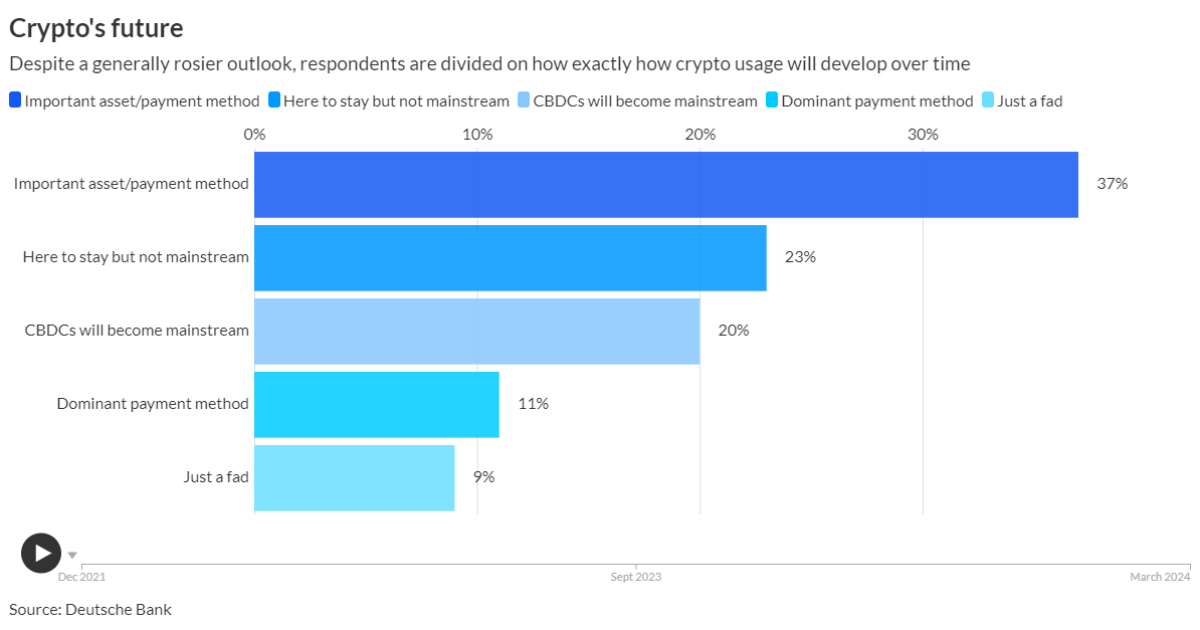News
What’s holding back cryptocurrency payments? | PaymentsSource

According to estimates from Deutsche Bank Research, the use of cryptocurrencies as a retail payment instrument is still limited and will only account for 3% of total payments within any country between 2021 and 2023.
However, as a means to improve cross-border transfers, crypto payments use cases are gaining favor, particularly for stablecoins, which tie their value to that of a government-issued currency. However, the lack of regulation discourages banks from adopting crypto technology for this purpose or any other.
Wells Fargo, for example, is evaluating crypto technology for potential transactional, transparency and settlement innovations, but does not accept cryptocurrencies in vaults, custody or other accounts, said Arushi Joshi, head of Wells’ distributed ledger and digital asset center Fargo. of excellence.
“Before we get involved in a meaningful way, we need to see a clear and cohesive regulatory framework that defines cryptocurrencies as financial instruments,” Joshi said.
The United States currently does not have uniform nationwide licensing requirements for cryptocurrency exchanges, which are required to obtain money transfer licenses in any state in which they operate. The United States has no equivalent to the European Union’s electronic money institution licensing regime, which requires non-banks to safeguard funds they hold on behalf of customers. Currently, the state with the most stringent crypto regulations is New York, with the New York Department of Finance’s BitLicense regime.
“Banks are throwing open the door to the benefits cryptocurrencies could bring to the industry,” said Keith Raymond, principal insurance analyst at U.S.-based Celent. Examples include processing payments, providing escrow services, facilitating international cash transactions and providing cryptocurrency loans, he said.
“However, regulatory concerns, volatility and the evolving nature of the cryptocurrency market pose challenges,” he said.
The state of stablecoins
Stablecoins lead the way in adopting cryptocurrencies as payment methods. This is due to their instant settlement on the blockchain and their ability to be combined with smart contracts. They are also designed to avoid volatility by tying their value to that of a government currency.
Some law firms using US cryptocurrency exchange Coinbase choose to get paid in the USDC stablecoin (USD Coin), as they get paid instantly rather than in three days. “Using USDC is cheap and fast; no middlemen and no waiting,” said Paul Grewal, chief legal officer at Coinbase.
Another reason why stablecoins are attractive to B2B payments is that they can be integrated into smart contracts on a blockchain. A smart contract eliminates manual processes and allows payments to be automatically executed if certain terms and conditions are met.
Cross-border remittances using stablecoins are currently the main use case, said James Wester, research director for digital assets and cryptocurrencies at US-based Javelin Strategy and Research. They offer a lower-cost, faster and more transparent alternative to existing methods like Swift for cross-border transactions, and that’s driving adoption, he said.
However, counterparty risk with stablecoins is higher than with traditional bank transfers, and cryptocurrency companies need to think about how to reduce counterparty risk, said Dima Kats, CEO of UK-based payments company Clear Junction.
Cryptographic regulations
The main disadvantage of stablecoins is that their one-to-one peg to the US dollar is not sufficiently regulated and several stablecoin failures have occurred, including that of TerraUSD, resulting in investors losing the value of their holdings. Typically, stablecoins are backed by municipal or government bonds rather than cash in bank accounts.
A stablecoin bill, the Clarity for Payments Stablecoin Act, is making its way through the House of Representatives. Separately, the Lummis-Gillibrand Payment Stablecoin Act was introduced as a bill in the Senate to protect consumers by requiring stablecoin issuers to maintain one-to-one reserves and banning unbacked algorithmic stablecoins.
Both bills aim to bring stablecoins into the same regulatory frameworks that govern traditional financial institutions.
“Ultimately, we expect members of Congress to consolidate around a single proposal that can move forward,” said Ji Kim, chief legal and policy officer of the Washington, D.C.-based Crypto Council for Innovation, a global alliance for the cryptocurrency industry.
Until legislation is adopted to regulate stablecoin issuers, concerns about the underlying assets of stablecoins will likely hold back significant adoption of stablecoins.
“Congress must pass stablecoin regulation to provide the necessary risk mitigation controls,” said Robin Cook, U.S. legislative policy counsel at Coinbase. “Regulation is necessary to ensure that a stablecoin issuer with a one-to-one dollar-backed currency can demonstrate that it has real liquid assets backing its stablecoins.”
Banks will consider adopting stablecoins as stablecoin bills progress through Congress, said Simon Jones, chief commercial officer at UK-based crypto payments firm Baanx Group.
How consumers use cryptocurrencies
The primary use of cryptocurrencies for the 10-20% of Americans who have owned them is investing, and investors need to cash out. According to Martha Bennett, vice president and principal analyst at US-based Forrester Research, most cryptocurrency payments are made by people who want to realize the gains made by holding cryptocurrencies.
However, the entire point-of-sale payment experience was designed with cards in mind, not only for payments but also to address fraud and refunds. So it’s a challenge for cryptocurrencies to match this experience and allow consumers to access their money quickly and seamlessly, Javelin’s Wester said.
Various payment system participants have been working on how to allow consumers to use cryptocurrency for retail payments. Most are hybrid methods that use an exchange to exchange cryptocurrencies for government-issued currency for payment.
Mastercard does not process cryptocurrency payments directly, but has launched card programs with 60 crypto wallet providers, according to Raj Dhamodharan, executive vice president of blockchain and digital assets at Mastercard. When cards linked to consumers’ crypto wallets are used for purchases, the cryptocurrency is converted by the cryptocurrency exchange into dollars and the merchant gets paid that way, he said. “We haven’t seen demand from merchants to be paid in cryptocurrencies,” he said.
Last month, San Francisco-based Stripe said it would allow its merchants to accept payments with USDC stablecoin starting this summer.
“Stablecoin payments are automatically settled in fiat for Stripe users, meaning they have a consistent and seamless experience across their card, banking and cryptocurrency transactions,” said John Egan, head of cryptocurrency at Stripe.
Companies like San Jose-based PayPal are merging stablecoins with existing payment experiences, said Marion Laboure, senior strategist at Deutsche Bank Research. Last month, PayPal said its cross-border money transfer service Xoom now supports the company’s PYUSD stablecoin. PayPal’s initial purpose in offering its stablecoin was for P2P payments.
Consumers can also make cryptocurrency payments directly from crypto wallets held by companies like US-based BitPay or Coinbase at a small number of online and in-store merchants.
However, while cryptocurrency spending increased 20% from January 1, 2024 to March 31, 2024, due to the bitcoin bull run, direct cryptocurrency payments are still minuscule, according to the BitPay Spending Report 2024. “Cryptocurrency payments rarely exceeded 3% of overall payments within any country between 2021 and 2023,” said Deutsche Bank Research’s Laboure. “Overall, the use case for cryptocurrency as a means of payment has not yet been fully realized.”
News
US Cryptocurrency Rules Delayed by ‘Never-Ending’ Lawsuits

Ripple CEO says cryptocurrency industry still seeking regulatory clarity from US
Speaking to Bloomberg News on Wednesday (July 17), Author: Brad Garlinghouse he said America is behind behind other countries which have already adopted cryptocurrency regulations.
“What we’re seeing, where it’s the UK, Japan, Singapore… even the European Union, more than two dozen countries have come together to provide a framework for cryptocurrency regulation,” Garlinghouse said.
“It’s frustrating that we as a country can’t get that regulatory framework in place. And instead, we have this never-ending lawsuit coming from the SEC that doesn’t really address the problem.”
Ripple has been the target of some of these legal disputes. Securities and Exchange Commission (SEC) sued the company in 2020, accusing it of conducting a $1.3 billion operation offering of unregistered securities tied to its XRP token.
However, last year a judge ruled that only Ripple’s institutional sales of XRP, not retail sales, violated the law, a decision widely seen as a victory for the cryptocurrency industry.
As PYMNTS noted at the time, that ruling has “far-reaching repercussions impact across the digital asset ecosystem, which has long maintained that its tokens do not represent securities contracts.”
However, Garlinghouse told Bloomberg on Wednesday that the company cannot wage multimillion-dollar legal battles over each token.
He spoke to the news agency from the Republican National Convention in Milwaukee, where the party is backing the candidacies of former President Donald Trump and Ohio Sen. J.D. Vance, both of whom are considered pro-cryptocurrency.
But Garlinghouse argued that cryptocurrencies “should not be a partisan issue,” and noted that he had recently attended a conference in Washington that included Democrats, including White House officials.
“I think they were there, listening to the industry… it was refreshing to start having that conversation,” she said.
President Joe Biden earlier this year he vetoed a measure which would have ended the SEC’s special rules for crypto-asset custodians. This legislation was supported by both the digital asset industry and the banking industry.
Ripple early this year donated $25 million to the cryptocurrency industry’s super PAC Fair Smoothiewith Garlinghouse stating at the time that such donations would continue every year, as long as the industry had its detractors.
Second Open SecretsWhich monitor spending For campaigns, the PAC has spent $13.4 million this year, much of it to help defeat Rep. Katie Porter’s (D-Calif.) U.S. Senate campaign.
News
The Future of Cybersecurity in the Cryptocurrency Industry

The cryptocurrency space has had a tumultuous journey, with its fair share of ups and downs. As we look to the future, one area that remains a constant focus is cybersecurity. The digital nature of cryptocurrencies makes them inherently vulnerable to cyber threats, and as the industry evolves, so does the landscape of potential risks.
In 2022, the cryptocurrency market faced significant challenges, with over $2 trillion in market value lost. This event served as a wake-up call for the industry, highlighting the need for robust cybersecurity measures. The future of cryptocurrency security is expected to see a shift towards more regulated and established institutions taking the reins of crypto technology and blockchain infrastructure.
The decentralized nature of cryptocurrencies offers numerous benefits, such as transparency and financial inclusion. However, it also introduces unique security challenges. The risk landscape is filled with threats such as hacking, phishing, ransomware attacks, malware, and social engineering. These threats not only lead to financial losses, but also damage the reputation and trust within the cryptocurrency ecosystem.
Mini-MBA Tekedia edition 15 ((September 9 – December 7, 2024) started recordings; Register today for discounts reserved for early bird customers.
Tekedia AI in Business Masterclass Opens registrations Here.
Join the Tekedia Capital Syndicate and IInvest in Africa’s best startups Here.
The decentralized nature of cryptocurrencies offers many benefits, but it also presents unique security challenges. Cyber risks such as hacking, phishing, and ransomware pose threats to the integrity of digital assets. The infrastructure that supports cryptocurrencies is not immune to vulnerabilities, including smart contract flaws and exchange hacks.
To address these vulnerabilities, the infrastructure that supports cryptocurrencies must be strengthened. Smart contract vulnerabilities, exchange hacks, wallet breaches, and flaws in the underlying blockchain technology are significant concerns that must be addressed to ensure the security and integrity of digital assets.
As cybercriminal tactics and techniques become more sophisticated, the cryptocurrency industry must stay ahead of the curve. The future will likely see more targeted attacks, exploiting weaknesses in infrastructure, networks, and human factors. This requires a proactive and multifaceted approach to cybersecurity.
To mitigate these risks, several measures must be adopted:
Strengthening security measures: Developers, exchanges, and wallet providers must improve security protocols, use strong encryption, implement multi-factor authentication, and conduct regular security audits.
Education and awareness: Users should be educated on best practices for protecting their digital assets, including using strong passwords, recognizing phishing attempts, and using hardware wallets for secure storage.
Looking ahead, the cryptocurrency industry is expected to see an increased focus on robust security measures. Blockchain projects and exchanges are likely to invest in advanced encryption techniques and decentralized storage solutions to protect user assets. The future impact of cyber risk on cryptocurrencies will depend on the collective efforts of stakeholders to address vulnerabilities and strengthen security measures.
Collective efforts by stakeholders in the cryptocurrency space are crucial to address vulnerabilities and strengthen security measures. While challenges persist, advances in cybersecurity technologies and practices offer hope for a more secure and resilient cryptocurrency ecosystem.
The future of cybersecurity in the cryptocurrency industry depends on finding a balance between innovation and regulation. It requires a collaborative effort from all parties involved, from developers to end users, to create a secure environment that fosters trust and growth in the industry. As we move forward, it is critical that lessons learned from past events guide the development of stronger security measures, ensuring the longevity and stability of cryptocurrencies as a vital part of the modern economic toolkit.
Like this:
Like Loading…
News
Bullish XRP and RLBK price predictions rise, outpacing the broader cryptocurrency market, prompting Shiba Inu holders to switch!

Bitcoin’s one-week surge from $60,000 has pushed other cryptocurrencies into an uptrend. However, for many altcoins, this trend has been temporary. Altcoins such as XRP and Shiba Inu (SHIB) have experienced price drops. However, Rollblock, a new altcoin on the Ethereum blockchain, has thrived during this period, attracting thousands of investors looking for long-term growth.
XRP’s Nearly 30% Growth Over Last Week Drops as Selling Pressure Increases
XRP is seeing further price decline as Ripple investors withdraw their profits from the token. The surge in XRP’s price to $0.64 in the past week has provided investors with a perfect opportunity to increase their returns in the short term. With the ongoing sell-off in XRP, XRP has jumped over 8% in the past day and is now trading at $0.59. However, analysts tracking XRP indicators predict that XRP could still extend its gains by over 30% in the coming weeks.
Shiba Inu (SHIB) marks its third consecutive day of losses
Shiba Inu (SHIB) is in a period of adjustment after a week of strong gains. In the last 24 hours, SHIB has seen a jump of over 7%, reflecting a natural market fluctuation. Analysts are observing a death cross on the Shiba Inu chart, which historically signals the potential for future opportunities as the market stabilizes. As investors explore new possibilities, some are diversifying into promising altcoins like Rollblock (RBLK) to strategically rebalance their portfolios and capitalize on the emerging trend.
Rollblock (RBLK) Up Another 7% as New Investors Join Pre-Sale
Rollblock (RBLK) has taken the cryptocurrency market by storm, having attracted investors from more popular altcoins like Shiba Inu (SHIB) and XRP. Rollblock’s growth is attributed to its utility in the $450 billion global gaming industry.
Rollblock aims to use blockchain technology to bridge the gap between centralized and decentralized gambling. With blockchain technology, Rollblock secures every transaction in its online casino, providing transparency and convenience to millions of players who are uncomfortable placing bets on other iGaming platforms.
This innovative use of blockchain technology in the industry has grown Rollblock to over 4,000 new users in less than two months. With plans to add sports betting, this number is expected to grow exponentially in Q3.
Rollblock uses a revenue sharing model that splits up to 30% of its casino’s weekly profits with token holders. This happens after Rollblock buys back $RBLK from the open market and uses half of it for rewards. The other half is burned to increase the price of $RBLK.
Rollblock price has seen four increases in the past month with $RBLK tokens now selling for $0.017. Analysts predict that at the current growth rate, Rollblock could increase by over 800% before the presale ends. For investors looking for a long-term token with growth potential, phase four is the best time to buy Rollblock before its price skyrockets!
Discover the exciting Rollblock (RBLK) pre-sale opportunities now!
Website:https://Rollblockpresale.io/
Social: https://linktr.ee/Rollblockcasino
No spam, no lies, just insights. You can unsubscribe at any time.
News
Texas Crypto Miners Turn to AI as Crypto Declines

As cryptocurrency mining becomes less profitable, Texas cryptocurrency mining companies are switching to supporting artificial intelligence companies.
Bitcoin miners, with their sprawling data centers and access to significant energy resources, are ideally suited for computationally intensive AI operations, and as cryptocurrency mining becomes less profitable, companies see this shift as a logical answer to their problems.
On Thursday, Houston-based Lancium and Denver-based Crusoe Energy Systems announced a multibillion-dollar deal to build a 200-megawatt data center near the West Texas city of Abilene to support advanced artificial intelligence applications such as medical research and aircraft design, CNBC reported. The plant represents the first phase of a larger 1.2 gigawatt project.
Lancium and Crusoe’s move into AI mirrors a broader trend among bitcoin miners. The combined market capitalization of the top U.S.-listed bitcoin miners hit a record $22.8 billion in June. Companies like Bit Digital and Hut 8 are diversifying into AI, with Bit Digital securing a $92 million annual revenue deal to supply Nvidia GPUs and Hut 8 raising $150 million to expand its AI data center.
But the growing popularity of these operations also presents challenges, particularly for the Texas power grid. Last month, the Electric Reliability Council of Texas announced that the state is expected to nearly double its energy production by 2030 to meet the high energy demands of data centers and cryptocurrency operations.
Lieutenant Governor Dan Patrick expressed concern about the projections.
“Cryptocurrency miners and data centers will account for more than 50% of the additional growth. We need to take a close look at these two sectors,” He wrote on Twitter/X. “They produce very few jobs compared to the incredible demands they place on our network. Cryptocurrency miners could actually make more money selling electricity to the network than they do from their cryptocurrency mining operations.”
Analysts predict significant growth in data center power capacity, which is expected to account for up to 9% of U.S. electricity consumption by 2030.
The operations also pose challenges for nearby cities. Earlier this month, TIME reported that a crypto-mining facility was seriously compromising the health of residents in the city of Granbury. TIME reported more than 40 people with serious health problems, including cardiovascular disease, high blood pressure and hearing loss. At least 10 of the residents needed to go to the emergency room or an urgent care facility.
The disturbances were caused by the extreme noise generated by the crypto-mining facility’s fans, which are used to keep the machines cool. While the proposed data center in Abilene would use liquid cooling systems, it’s still unclear whether the facility’s operations would pose a health risk to local residents.
-

 Nfts1 year ago
Nfts1 year agoShardLab Launches ZK-Based Tool for Digital Identity and NFT Vouchers
-

 News1 year ago
News1 year agoWallet recovery firms are abuzz as stranded cryptocurrency investors panic in the bitcoin boom
-

 Bitcoin1 year ago
Bitcoin1 year agoBitcoin, Ethereum, Solana and Cryptocurrency Markets Look Ready to ‘Send’ as Stars Align, According to Investor Chris Burniske
-

 Altcoins1 year ago
Altcoins1 year agoThree Altcoins Poised for Significant Growth in 2024: ETFS, OP, BLAST
-

 Altcoins1 year ago
Altcoins1 year agoAccumulate these altcoins now for maximum gains
-

 Nfts1 year ago
Nfts1 year agoOG Crypto Artist Trevor Jones Unveils Groundbreaking Collection of Ordinals | NFT CULTURE | NFT News | Web3 Culture
-

 Bitcoin1 year ago
Bitcoin1 year agoBillionaires are selling Nvidia stock and buying an index fund that could rise as much as 5,655%, according to some Wall Street analysts
-

 Videos9 months ago
Videos9 months agoKamala just won the boner! [Bad For Crypto]
-

 Videos1 year ago
Videos1 year agoLIVE FOMC 🚨 Could be CATASTROPHIC for Altcoins!
-

 News1 year ago
News1 year agoA Guide for Newcomers & Beginners – Forbes Advisor
-

 Videos1 year ago
Videos1 year agoAttention: a historically significant BITCOIN signal has just appeared!
-

 Videos1 year ago
Videos1 year agoSTOCK MARKET FUD! ⚠️ [Why This Is GREAT For Bitcoin Traders!]















